I recently re-read Scott McCloud‘s awesome 1993 treatise on comics Understanding Comics: The Invisible Art. This book, along with McCloud’s subsequent comics volumes, is really the best resource for exploring comic book vocabulary – ie: how comics do what comics do.
McCloud’s chapter 4, on Time Frames, touches on what I’ve been calling a “multi-panel pan sequence” (though I’ve been thinking of trimming this to a “multi-pan”) and he calls this sequence a “polyptych.”
McCloud does this great demonstration where he shows a single panel taking place over a duration of time, not a single discrete moment:
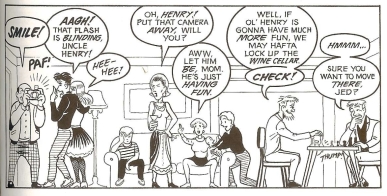
Single comic panel depicting action taking place over a duration of time - written and drawn by Scott McCloud
Then he breaks it out into a multi-pan:
I wasn’t sure what to call these sequences, but McCloud has succintly labeled them polyptychs!
So I’ve been thinking… should I go back and re-label all the stuff I’ve been calling multi-pans? McCloud is the trusted, perhaps definitive, expert in the field. I wrote about these polyptychs here and here, and collected examples of from the 1900s to the present day in this multi-decade index. I won’t retroactively modify all those, but I think I’ll use polyptych and multi-pan interchangably.
Also, I’d like to explore where each of these terms comes from.
Polyptych is a term from the visual arts world, meaning “a work consisting of four or more painted or carved panels that are hinged together.” (definition grabbed from here.) It’s “four or more,” because fewer than four would be a diptych or triptych – two and three pieces, respectively. Interestingly, “ptych” comes from a greek word for “fold,” so polyptych more or less means “many folds.”
Artists now and then paint multiple distinct pieces that go together, generally mostly diptychs and triptychs. Triptychs were fairly common as medieval altarpiece paintings that fold-up when not in use, for example follow this link to one by Hans Memling.
I am a big fan of Max Beckmann’s triptych paintings, especially one entitled Departure, which belongs to the Museum of Modern Art in New York.
McCloud makes a lot of sense in using polyptych to describe a comic book sequence that spreads across multiple panels with a common background. McCloud has lifted the term from visual art and applied it to comics.
In describing the same thing, I coined the term multi-panel pan sequence -which is quite bulky, no? McCloud only used one word, just nine letters. I used four words, centered on a word from film: the “pan” – as in “a shot in which a stationary camera turns horizontally, revealing new areas.” (Definition grabbed from here.)
Given that comics are sort of a hybrid (or, not as nicely, a bastard) art form that shares characteristics with visual arts and with film (plus writing, music, and more.) McCloud even states “before it’s projected, film is just a very very very very slow comic.” It makes sense that comic book vocabulary would be lifted from painting and from film… though both my and McCloud’s wording choices have slight flaws, because comics aren’t exactly film or painting.
A polyptych painting generally includes images spread over a shared background/landscape, for example: Memling’s altarpiece. It can, however, include images that are linked thematically, with no shared background, for example: Beckmann’s Departure (above.)
A cinematic pan, as far as I can imagine, always unfolds over time. Though generally a comic polyptych unfolds over time, it’s possible (though uncommon) for them to depict simultaneous occurances – especially wordless polyptychs. Below is an example from Frank Miller’s Ronin – there’s no real pan unfolding in this sequence.
Sometimes this can seem pretty unnecessary. Miller’s image would work well as one panel without the gutters. But sometimes… it just looks cool! It kind of reminds the reader that this is a comic book… On stage, it might be described as “theatrical.”
Comics, though actually older than cinema, are still in a sort of in their infancy. This is because, as an art form, comics haven’t really been taken seriously by most critics, academics, and by the general public. I think that the reason for this is that, for the most part, comics haven’t taken themselves all that seriously either. They’ve been mostly throw-away stories cranked-out under deadline. There are occasional moments of genius (and even the cranked-out stuff is often interesting in what it has to say about popular culture) but most comic books don’t hold my adult interest they way they held my adolescent attention. Thanks to quite a few creators, including Craig Thompson, Alison Bechdel, Mike Mignola, Alan Moore, Art Spiegelman and others, this is changing.
Given the comics medium’s infancy, the vocabulary for describing and critiquing comics hasn’t quite fully developed. Pioneers, including Scott McCloud, Will Eisner, and a few others, have laid some excellent foundations for these discussions. In describing comics, they’ve used terms from painting, theater, and film… but they’re sometimes describing things that are unique to comics. The comics polyptych is wonderfully unique. It has imperfect analogs in painting and film… but it doesn’t really exist in painting or in film… it’s pure comics.
Someday maybe, a hundred years from now, a young writer will see a medieval triptych for the first time and say “wow – that’s kinda like those comic book polyptych things!”
Tags: comics, multi-panel_pan, polyptych, Scott_McCloud, Understanding_Comics
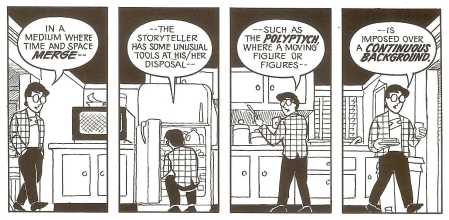
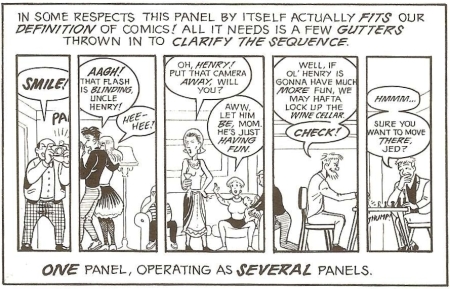
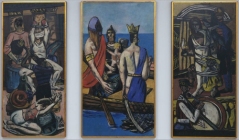
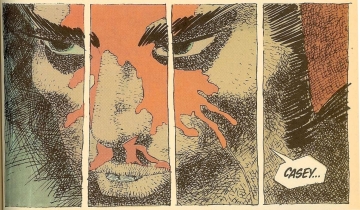
9 September 2014 at 5:42am |
[…] de nommer « polyptiques » ce type de séquences (différents exemples ici et là). Autre exemple « bâtard » de nature plus expérimentale : Travelling Square […]
11 January 2015 at 1:34pm |
[…] https://theperiodicfable.wordpress.com/2011/11/22/comics-vocabulary-polyptych/ […]
14 April 2020 at 4:03am |
[…] there are so many good pages from this prog, but for impact (literally in one panel) and use of multi-pan / polyptych scene (basically, one picture split into four panels, each panel taking place in subsequent time […]